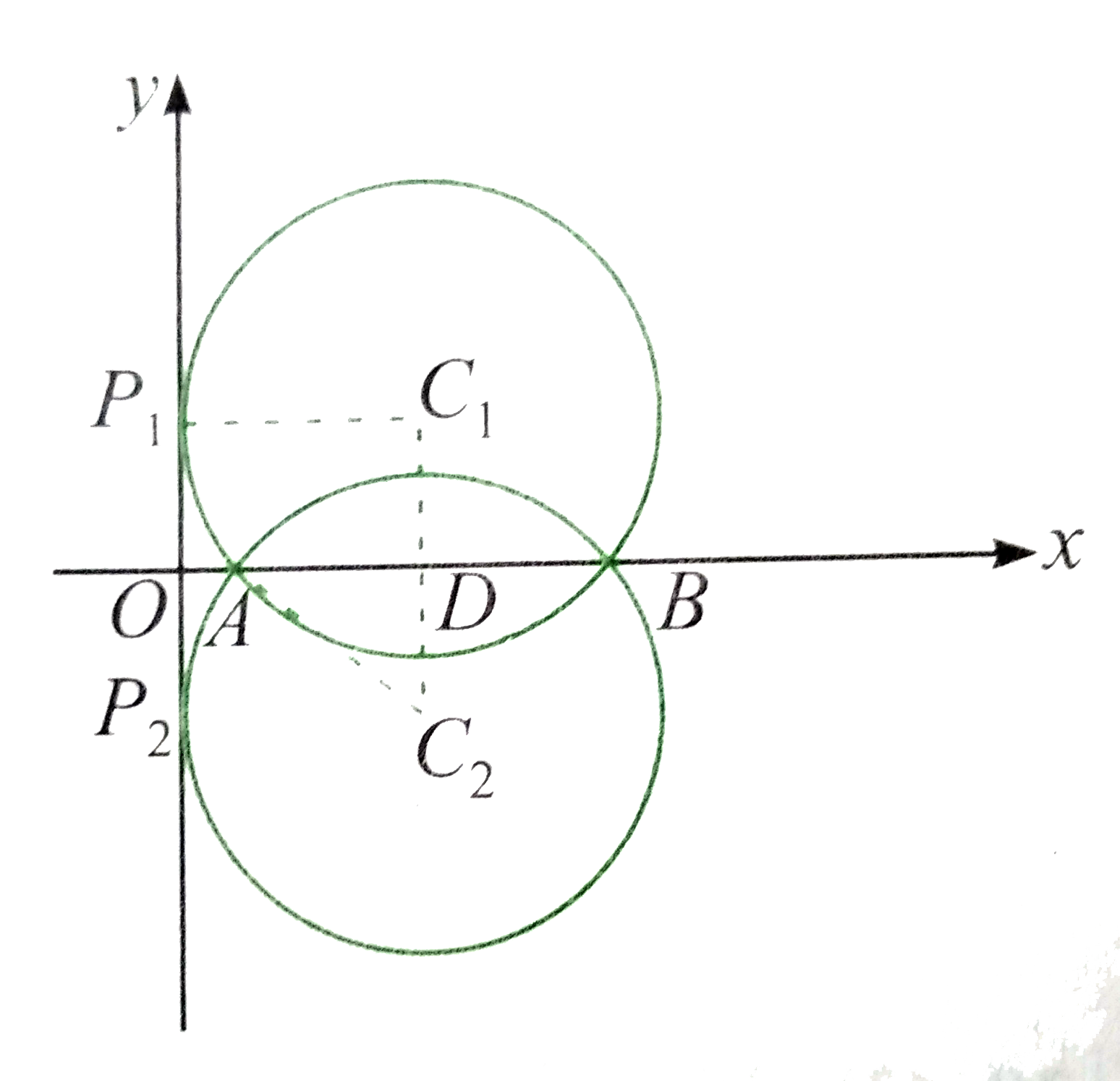The circle which can be drawn to pass through (1, 0) and (3, 0) and to touch the y-axis intersect at angle θ. Then cosθ is equal to 12 (b) −12 (c) 14 (d) −14Solution in Bengali
1/2
1/3
1/4
−1/4
The correct Answer is:1
Let A≡(1,0),B≡(3,0) and C1 and C2 be the centers of circles passing through A and Band touching the y-axis at P1 and P2 respectively. If r is the radius ( here radii of both circles will be the same ).
C1A=C2A=r=OD=2
and C1=(2,h)
or C1≡(2,√3),C2≡(2,−√3)
If ∠C1AC2=θ, then
cosθ=AC21+AC22−C1C222AC1×AC2=12

Topper's Solved these Questions
- BOOK - CENGAGE PUBLICATIONCHAPTER - CIRCLE EXERCISE - Multiple Correct Anser Type29videos
CIRCLE
- BOOK - CENGAGE PUBLICATIONCHAPTER - CIRCLE EXERCISE - Linked Comprehension Type (For Problem 1-3)3videos
CIRCLE
- BOOK - CENGAGE PUBLICATIONCHAPTER - CIRCLE EXERCISE - CONCEPT APPLICATION EXERCISE 4.172videos
CIRCLE
- BOOK - CENGAGE PUBLICATIONCHAPTER - BINOMIAL THEOREMEXERCISE - Comprehension11videos
BINOMIAL THEOREM
- BOOK - CENGAGE PUBLICATIONCHAPTER - CIRCLESEXERCISE - Comprehension Type8videos
CIRCLES
Similar Questions
about to only mathematics
03:21View SolutionEach side of a square is of length 6 units and the centre of the square Is ( - 1, 2). One of its diagonals is parallel to x+y=0. Find the co-ordinates of the vertices of the square.
06:09View SolutionThree concentric circles of which the biggest is x2+y2=1, have their radii in A.P If the line y=x+1 cuts all the circles in real and distinct points. The interval in which the common difference of the A.P will lie is:
02:39View SolutionConsider a G.P. with first term (1+x)n, |x|<1, common ratio 1+x2 and number of terms (n+1). Let 'S' be sum of all the terms of the G.P., then
The coefficient of xn is 'S' is05:38View Solution
In the diagram as shown, a circle is drawn with centre C(1,1) and radius 1 and a line L. The line L is tangent to the circle at Q. Further L meets the y-axis at R and the x-axis at P in such a way that the angle OPQ equals θ where 0<θ<π2.
Coordinate of Q is03:54View SolutionLet C be the circle with centre at (1, 1) and radius = 1. If T is the circle centred at (0, y), passing through origin and touching the circle C externally, then the radius of T is equal to (1) √3√2 (2) √32 (3) 12 (3) 14
03:14View SolutionThe circle which can be drawn to pass through (1, 0) and (3, 0) and to touch the y-axis intersect at angle θ. Then cosθ is equal to (a)12 (b) −12 (c) 14 (d) −14
05:02View SolutionIf the circles x2+y2−9=0 and x2+y2+2ax+2y+1=0 touch each other, then α is −43 (b) 0 (c) 1 (d) 43
05:15View SolutionIf a circle touches y-axis at (0, 4) and passes through (2, 0) then which of the following can not be the tangent to the circle
04:12View SolutionA circle passing through (1,1) and (3,3) intersect the positive x -axis at A(a,0) and B(b,0) .Then ab=?
05:32View SolutionA circle passing through (1,1) and (3,3) intersect the positive x -axis at A(a,0) and B(b,0) .Then ab=?
01:47View SolutionThe circles which can be drawn to pass through (3,0) and (5,0) and to touch the y-axis intersect at an angle θ , then cosθ is equal to
06:06View SolutionThe circle which can be drawn to pass through (1, 0) and (3, 0) and to touch the y-axis intersect at angle θ. Then cosθ is equal to (a)12 (b) −12 (c) 14 (d) −14
03:32View SolutionIf the circles x2+y2−9=0 and x2+y2+2αx+2y+1=0 touch each other, then α is (a)−43 (b) 0 (c) 1 (d) 43
06:14View SolutionIf the circles x2+y2−9=0 and x2+y2+2ax+2y+1=0 touch each other, then a is −43 (b) 0 (c) 1 (d) 43
03:50View SolutionLet C be the circle with centre at (1, 1) and radius = 1. If T is the circle centred at (0, y), passing through origin and touching the circle C externally, then the radius of T is equal to (1) √3√2 (2) √32 (3) 12 (3) 14
04:46View Solution

